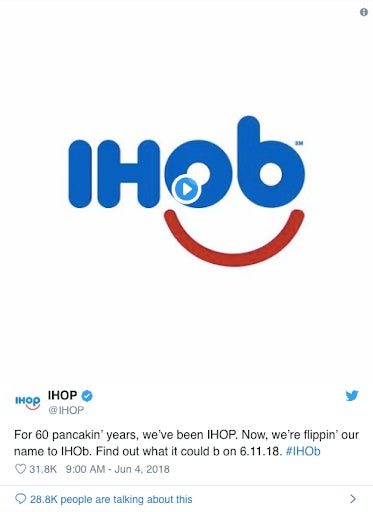Summary of key themes
Summary of key themes
- The foundations of a solid rebranding effort
- Reasons to consider rebranding
- Rebranding when things go wrong
- Rebranding cheat code
- Final takeaways
Rebranding saved Harley-Davidson from the brink of bankruptcy, creating an iconic brand now deeply associated with a freewheeling American lifestyle. Rebranding helped Uber expand from a Silicon Valley start-up to a "global platform for mobility," instantly recognizable to passengers across the globe. And IHOP had their new company name off the tip of everyone's tongues as they sought to change their position in the market when launching their new burger business.
We've looked at rebranding strategies from myriad different angles, and it's clear that rebranding is a powerful tool if wielded carefully and strategically. In this chapter, we'll review the key themes that we've covered and leave you with actionable suggestions as you look to rebrand your own product or company.
The foundations of a solid rebranding effort
Your brand is one of your greatest assets, and you'll need to have buy-in from inside and outside your organization to make your rebranding project a success. The following foundational elements will help ensure that your new brand resonates with your target audience.
User research and "listening" come first
Just as an effective sales rep starts the sales process by listening to a potential customer's needs, brand managers should begin the rebranding process by listening to the feedback and perceptions of prospects, customers, and their internal teams. Many brands fall into the trap of trying to change brand positioning in a way that's self-serving rather than based on what their audience wants.
A formalized user research process at the outset will help you discover what is meaningful and important to your customers. Without taking the time to listen, you'll simply be guessing when it comes to identifying important points of differentiation.
Differentiation within your industry is essential
Your rebranding effort should fulfill one objective above all else: It should help differentiate your brand in the market. Differentiation takes the emphasis off of price and strategically positions your brand's unique attributes as better for a specific subset of target customers. Often, clearly identifying your brand's main adversary can help make your market position really stand out in the mind of the consumer.
The points of differentiation that you're looking for are truths that are right in front of you — not invented fictions.
If you compete in a market against very similar products, remember that — even if you're selling bottled water — all products can be differentiated.
All it takes is a careful inspection of your product or service to find your points of differentiation.
Whatever your reason for rebranding, you can't erase a consumer's memory or perception of your brand: if you try to completely step away from the brand that you once were, you'll likely fail. Instead, seek to find an existing truth in your brand and communicate it in a way that's clearer, more understandable, or more beneficial to the consumer.
Remember Bill Weintraub, the former CMO of Kellogg's who rebranded All-Bran cereal around the cancer-preventing superpowers of dietary fiber? The fiber was there all along — it merely took reframing the benefits of dietary fiber to differentiate the brand effectively.
Brands should be aspirational for consumers, but not for companies
Your rebrand must reflect the company that you are, not the aspirational attributes of the company that you'd like to one day become.
A brand is not a disguise; if you pretend to be something that you're not, your customers will quickly expose you.
Your new brand can be aspirational for your customers — in fact, it should help your customers realize a better version of themselves. This often takes the form of a brand selling a lifestyle desired by their target consumers. Remember Harley-Davidson's evocative positioning statement?
The only motorcycle manufacturer
That makes big, loud motorcycles
For macho guys (and "macho wannabes")
Mostly in the United States
Who want to join a gang of cowboys
In an era of decreasing personal freedom.
The company's rebrand was massively successful in hinging their brand on ideals of Americana and personal freedom.
Reasons to consider rebranding
Here are three of the most common and compelling reasons to consider a rebrand. Each of these represents an opportunity for a rebrand to have a direct impact on your company's bottom line.
Rebranding to change your position in the market

If your company is seeking to change its position in the market — like IHOP did when they rebranded as IHOb in an effort to introduce their new line of hamburgers — rebranding can be an effective strategy.
This tactic should only be used as a last resort, though, as you don't want to get in the habit of rebranding every time you introduce a new product or want to change consumer perceptions. Doing so will leave your audience utterly confused.
As you rebrand to change your market position, focus on maintaining the core, favorable attributes of your brand while dropping the aspects of your current positioning that are no longer relevant or compelling. And don't be afraid to make a big splash as you unveil your new brand — changing consumer perceptions is hard, so be bold.
Rebranding to support international expansion
For many brands, rebranding to support international expansion is a necessary step in the natural evolution and growth of the business. Few companies have faced this challenge as acutely as Uber, whose future growth relies on drivers and passengers being able to easily recognize Uber vehicles in markets across the globe.
As you rebrand with this objective in mind, focus on using straightforward visual communication that's easily understood by customers across cultures; design function trumps design form. You'll also want to keep your product's messaging and positioning consistent, but adapt your tactics for the nuances and sensitivities of each international market.
For example, Uber should maintain its focus on mobility across all the markets it serves, but it would be appropriate for the company to contextualize its advertising for each unique market by employing local celebrities in their ads.
Rebranding around mission and values
Consumers are increasingly willing to pay more for products or services made by companies that share their personal beliefs and values. If your existing brand isn't reflective of your core values, this provides an opportunity to rebrand and create an experience that resonates more deeply with your target customers.
Rebranding around your mission and values must be done authentically. Brands must be willing to make sacrifices in service of their values — that's how consumers know that the brand's mission and values are real, substantiated, and meaningful. Patagonia donating 100% of their Black Friday sales to environmental charities is a perfect example of a sacrifice made in service of mission and values.
Your mission and values are worthless unless they permeate every aspect of your brand experience and drive your actions as a company.
Rebranding when things go wrong
In business, sometimes things will go wrong. Whether your brand is facing an external crisis beyond your control or you created your own rebranding disaster, follow the guidance below to minimize the impact of the event.
Rebranding in crisis
All enduring brands will at some point be faced with crisis. The mayor of picturesque Dauphin Island, Alabama never imagined he'd wake up one spring morning to discover an oil-polluted coastline that threatened the lives of local marine life, let alone the upcoming tourist season. When mistakes happen and crisis occurs, remember this one key tenet:
Consumers don't blame brands for situations outside of their control, but they do blame them for not having a crisis management strategy.
When a crisis occurs, move quickly to acknowledge the crisis, own up to mistakes, and show empathy to those affected. While you want to acknowledge the event quickly, avoid making sweeping changes (like name changes) in the heat of the moment; doing so can easily discard brand equity that's taken years to build.
Rebranding disasters
Rebranding disasters are self-inflicted rebranding mishaps. They happen for a variety of reasons, but the most common is that the brand is acting in its own self-interest rather than the interests of its customer base.
Name changes can be particularly catastrophic (remember when Overstock.com rebranded as O.co?), and the benefits of a name change should always be carefully considered before taking this disruptive step. Changing your brand's name can easily throw away your existing brand equity.
While any rebranding project comes with some inherent risk, you can mitigate your company's exposure and increase the chances that the rebrand is successful by testing new brand concepts with your internal team, customers, and prospects from new markets prior to officially unveiling your new brand. Doing so is always worth the investment of time and effort.
Rebranding cheat code
Your rebrand can be even more effective if you leverage the strategies listed below. These tactics can make your brand more relevant, create fierce customer loyalty, and help you compete more effectively while charging a premium price for your products or services.
Harness the power of in-person and shared experiences
In today's online world, it's all too easy for brands to ignore the power of in-person experiences. But humans connect on a deeper level when experiences are shared and happen in-person. As such, in-person experiences often represent the strongest brand-building opportunities by appealing strongly to customers' emotions. Think of the motorcycle rides Harley-Davidson organizes for their HOG group members, for example: those experiences create memories that are far more meaningful for Harley customers than any sort of online interaction.
As part of your rebranding effort, focus on creating an inclusive brand community that's connected by shared experiences. Your brand exists to serve this community, rather than the community existing to serve your brand.
Create a dynamic brand
Brands today need to adapt seamlessly to both the physical and digital world. Your brand needs to be as effective on a Times Square billboard as it is on an app icon on the screen of a smartphone.


Creating a dynamic brand gives brand managers the ability to consistently reinvent themselves and present fresh and contextually relevant versions of their brand without losing their most identifiable characteristics. This allows your brand to not only meet the demands of the physical and digital world, but also to adapt to current events and happenings.
As you embark on creating a dynamic brand, begin by assembling a "kit of parts." This will help you identify the elements of your brand that will remain static while the rest of your identity can be liquid and subject to change.
Leverage your existing customers to create user-generated content
User-generated content can be a particularly effective accelerant to a successful rebranding effort. Consumers tend to trust other consumers more than they trust brands, so content created by your users can speed up the process of changing perceptions about your brand.

Brands that tap into user-generated content can also achieve significant advantages when it comes to exposure, especially on social media platforms.
As the costs of advertising on platforms like Facebook and Google continue to rise, companies like Chubbies have grown largely on the back of marketing strategies where their customers are producing their marketing materials for them.
Your customers represent your biggest ally in quickly and effectively changing perceptions of your brand — stop and think about how they can help you bring your rebrand to life.
Achieve cult status with your brand
A strong brand allows you to charge a premium price for your products or services while creating fierce customer loyalty. And with those objectives in mind, brand managers can learn from and adopt many of the same principles that have been used over the years in the formation of cults. After all, you're looking to build a loyal following.
Whether it's leveraging a charismatic leader like Steve Jobs at Apple or formalizing a membership initiation process like Real Madrid has done for their fans, try out some rebranding strategies from others who have developed a cult-like following. Doing so can lead to rabid evangelism and increased customer loyalty.
Final takeaways
- Rebranding is a major undertaking — make sure you have valid reasons for taking it on that serve the best interests of your customers.
- Rebranding requires complete commitment. Internal stakeholders, your existing customers, and prospective customers should all be involved in the process.
- Rebranding affords your company or product a significant opportunity to change its positioning in the market and differentiate in ways that matter to your audience.